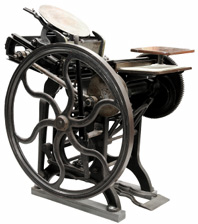Buying a Treadle Platen

Having once been caught with a bad buy, I wouldn't like any one else to suffer the expense and disappointment of discovering their new treadle platen is fit only for the scrap heap (or museum, perhaps?).
It's not usually the seller's fault – often they're clearing out a deceased relative's print shop and have absolutely no experience with any of the equipment they're selling. So it's down to we buyers to make an informed decision before we part with our cash or hire a van to collect!
What to Look For
The essence is that one main bearing is the key to the proper functioning of such a press, either where the head carrying the type forme moves, or where the forme stands still, and the platen moves to meet it.
For both types the achilles heels are the main pivot bearings. There's usually two, down at floor level, where they were likely to be neglected; dripped on with ink and solvents but rarely got the 3-in-1 type oil they wanted.
To see what sort of condition these bearings are in, take a firm hold of the moving head and wiggle it from side to side (it takes a little strength to do it properly). Too much wiggle? Get down on your knees – lay flat if you can – with a torch, and have a very close look whilst someone else wiggles for you. Take care not to get squashed!
Repairing Wiggly Bearings
The time I was robbed, the press was located very close to a wall, and once I got it home I found little slivers of lead and brass had been used to take up the bearing slack!
A problem like that can be repaired (they call it ‘re-bushing’) by a suitably competent engineer. If you want to go down that route, try an agricultural engineer who's likely to be more than familiar with antique and probably brittle cast iron. But if you have the option of acquiring another press, with fewer problems, then...
Accessories
Does it have the vital rollers, or at least the roller stocks (the very accurately turned shaft at the core of a roller)? And the runner wheels that go on either end (usually separate items).
It doesn't matter too much if the roller coverings are in a terrible state – and they often will be – they can be re-covered, but missing roller stocks and/or runners would be a bit of a problem. Unless the press is a very commonly encountered model there will be the problem of providing dimensions for an engineer to turn up replacements for you on his lathe.
There's a similar problem with chases. They can be simple rectangles which any welder can make up for you, or they may be cast iron with cast-in retaining ledges, recesses or shoulders &ndash not so easy to replace!
Most of the other bits and bobs are not a problem to replace – or do without – but a missing ink disc would be a bit of a problem.
Motors and Brakes
If the press is motorised, does the effective gearing-down from the motor running speed make the press open and close at a slow enough speed that suits someone new to it? Does all this need changing anyway, due to ancient motor etc (do not hesitate about this) and indeed does this presumably ancient contraption have any sort of guard? You have been warned!
The normal flywheel packs a load of kinetic energy to get the press past the moment of impression, and is almost impossible to stop dead in emergency, even if the machine has got a foot brake. One of our ancient presses has a foot brake, and one does not. You can NOT stop the press by pushing back on the platen, always let the sheet of paper go to waste – new fingers are not readily available as spares!
You Might Also Like...
